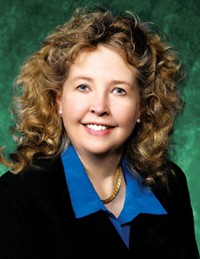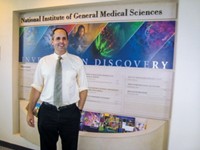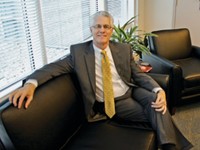Advertisement
Grab your lab coat. Let's get started
Welcome!
Welcome!
Create an account below to get 6 C&EN articles per month, receive newsletters and more - all free.
It seems this is your first time logging in online. Please enter the following information to continue.
As an ACS member you automatically get access to this site. All we need is few more details to create your reading experience.
Not you? Sign in with a different account.
Not you? Sign in with a different account.
ERROR 1
ERROR 1
ERROR 2
ERROR 2
ERROR 2
ERROR 2
ERROR 2
Password and Confirm password must match.
If you have an ACS member number, please enter it here so we can link this account to your membership. (optional)
ERROR 2
ACS values your privacy. By submitting your information, you are gaining access to C&EN and subscribing to our weekly newsletter. We use the information you provide to make your reading experience better, and we will never sell your data to third party members.
Policy
Matthew Platz Takes The Helm
Head of NSF Chemistry Division sees science as the way to tackle society's problems
by David Pittman
November 1, 2010
| A version of this story appeared in
Volume 88, Issue 44

As a postdoctoral student at the University of Chicago, Matthew S. Platz applied for his first National Science Foundation grant in 1978. NSF accepted Platz's proposal to study reactive intermediates, and since that time—a span of more than three decades—the New York City native has received nearly $5.5 million from NSF in a constant stream of support.
The physical organic chemist now is moving from receiving federal research money to doling it out as he takes over as director of the Division of Chemistry at NSF. The term, which started on Oct. 1, is a one-year commitment that can be renewed for up to four years. "NSF has been very good to me, very supportive of me, and I hope I can pay that back somewhat," Platz told C&EN last month in his new office at the agency's headquarters in Arlington, Va.
The 59-year-old comes to NSF from Ohio State University, where he moved up the academic ladder after starting as assistant professor in 1978. He was named chemistry department chair in 1994 and was promoted to vice provost in 2006. Described by colleagues as a humorous, outgoing individual, Platz has the well-balanced blend of lab expertise and academic executive know-how needed for his new NSF job.
"Dr. Platz is both a highly distinguished scientist and university administrator, with a deep understanding of chemical sciences and their impact in other disciplines," says Ed Seidel, assistant director for the Mathematical & Physical Sciences Directorate at NSF and Platz's new boss. "These are exactly the qualities we were looking for in our search to find a leader for the Division of Chemistry at NSF."
Platz admits that he needs to familiarize himself with the latest advances of chemistry outside of his field in order to make appropriate funding decisions on proposals. "I have to learn about the great chemistry that's going on in this country, the chemistry that is creating new knowledge that has no perceived use at this time, and to find the best basic research that is use-inspired," Platz says. "I have to learn and identify that, and I have to bring that to the attention of all parts of the [science, technology, engineering, and mathematics] community so that people appreciate what chemistry is doing to solve problems right now."
With the public increasingly turning to science to solve pressing issues such as developing better and more sources of renewable energy, Platz says he wants to help identify and fund the chemistry that will address those issues and shape the future. "The country has never needed chemists more. The country needs chemists to do chemical manufacturing from nitrogen or carbon dioxide. If we can figure that out, we can create a lot of middle-class jobs," Platz says. "The country needs us to figure out how to turn sunlight into electricity. The country needs us to figure out how to store energy in chemical bonds."
It's the opportunity to single out really significant work that excites Platz. He inherits a division in the agency responsible for nearly 20% of all the country's federally funded research in chemistry. "The opportunity is there for chemists to create new industries, new jobs, economic prosperity," he says. "And that excitement is part of the reason I was humbled and delighted to be offered this position."
Platz is one part of recent leadership changes occurring at NSF. In September, the Senate confirmed Subra Suresh, 54, as the next NSF director for a six-year term. Ian M. Robertson, an engineering professor at the University of Illinois, Urbana-Champaign, will take over as director of the Division of Materials Research effective on Jan. 3, 2011 (C&EN, Aug. 16, page 11).
As division director, Platz provides a final review and vote on each grant application after NSF program directors make a recommendation to fund or not. Platz can either agree to fund a proposal or not. "One of the things that attracted me to this job was the fact that I would be spending more of my time reading and thinking about chemistry rather than being a bean counter at the university," he says.
Achieving his goals may be difficult. With the balance of power in Congress in limbo, Platz steps into the NSF post at a time of fiscal uncertainty for federal agencies that are subject to the whims of lawmakers. Meanwhile, demand for the agency's funds continues to grow, and an influx of grant proposals is putting additional pressure on the agency's staff.
"Many of the issues at the university and NSF are the same," Platz says. "We live in a time in which workload is increasing but the number of people available to do the work is constant at best."
One complicating factor is that NSF received $3 billion from the American Recovery & Reinvestment Act of 2009, the economic stimulus bill. This provided a short-term windfall of research money to the basic sciences (C&EN, May 18, 2009, page 6). But many of the new grants were awarded for two- or three-year spans, and the outgoing NSF Chemistry Division director, Luis Echegoyen, told Platz before leaving office that the division should expect a surge of grant proposals from researchers seeking renewal of stimulus-funded projects.
Moreover, Congress' renewal of the America Competes Act, the 2007 law that sought to double the research budget of NSF and two other federal science agencies, is still in doubt. Even if NSF received the increase in its budget authorized in the act, projects funded with stimulus money would have a tough time being renewed in the next couple of years.
"I am confident that our Congress is beginning to realize that putting money into basic research at NSF is not an expense, but an investment, just like China has realized," says Echegoyen, who left the agency in mid-August and became the Robert A. Welch Chair in Chemistry at the University of Texas, El Paso. "I think that our Congress is very, very slow, but they are catching on to the idea that this is something they need to do."
Platz says a "major challenge" before him is addressing the falling success rate and the increasing number of proposals that come into the division. NSF's budget has increased by 25% in the past five years, and researchers have increasingly turned to the agency to fund their work. NSF's budget has jumped from $5.5 billion in 2005 to $6.9 billion last year. In fiscal 2010, the Chemistry Division reviewed 1,641 research proposals and made 381 awards, a success rate of 23%. The success rate was 35% as recently as 2000. The problem is that, at a success rate hovering around 20%, many very good proposals wind up not being funded.
Many observers view the increase in proposals to be the main problem facing the Chemistry Division. Not only is it harder for researchers to get funded through NSF's Chemistry Division, but program directors, those who usher grant proposals through the review process, are at their limit in terms of workload. Although NSF's budget has increased, the money goes toward research, not additional staff.
"More money to distribute is an obvious short-term solution to the problem," Platz says. "Any long-term solution will involve thoughtful engagement with the community, and thinking that through is high on my list of priorities."
A similar funding increase occurred at the National Institutes of Health when its budget doubled from $13 billion to more than $26 billion from 1999 to 2004. The number of grant applications to the agency more than tripled. Since that time, however, funding increases have been low, and more grants are being turned down. For fiscal 2009, the most recent year for which data are available, NIH funded less than 21% of the grant proposals it received.
Echegoyen's top internal priority as division director was to lift chemistry from the bottom of the funding pool among the five divisions in the Mathematical & Physical Sciences Directorate at NSF. With its $234 million budget last year, chemistry received less research money than did astronomy, materials research, math, and physics. The difference between chemistry and astronomy, the next-lowest-funded division, shrank from $30 million to roughly $2 million during his four years at the post.
Platz acknowledges that part of his duty is to rally support for chemistry research and advocate for its potential and successes. "At Ohio State, I was basically selling the importance of science to the university president and provost and to state government," he says. "Here, I'm selling the importance of chemistry to my associate director, Ed Seidel, and ultimately to the director of the foundation and the executive branch of government."
Platz observes another way that the division is now better positioned to support today's chemistry. Last year, the Chemistry Division was realigned into nine study areas, an increase from the former two (C&EN June 8, 2009, page 44). The change adjusts for the increasingly interdisciplinary approach both within chemistry and with other fields. It is now "easier for us to map certain areas of chemistry with our natural partners in biology and the environmental sciences, the material sciences. The realignment has really facilitated interdisciplinary research," Platz says. "I think my job is now to make that realignment work and then to assess how well it's working in the future."
Platz has plenty of experience to draw from as he takes on the myriad responsibilities of division director. He's an accomplished researcher, valued administrator, and respected teacher. His research as a physical organic chemist focused on studying the structure and behavior of reactive intermediates, particularly carbenes, nitrenes, and reactive oxygen species. Platz, who received his doctorate in organic chemistry from Yale University in 1977 while studying under Jerome A. Berson, has authored almost 300 peer-reviewed papers and claims 13 patents.
While at Ohio State, Platz received many teaching awards in his 27 years in front of the classroom. His former boss, Executive Dean of Arts & Sciences Joseph E. Steinmetz, says Platz spent a great deal of time with graduate and undergraduate students even after taking a more administrative role as vice provost in July 2006. Platz cared deeply about the quality of the programs Ohio State offered. "I suspect that will translate into a real concern and care for those student programs that NSF sponsors as well," Steinmetz says.
Platz, who admits he probably knows more about the problems in chemistry education than he does about the solutions, calls first-year chemistry courses "the gatekeeper for careers in the allied health professions. If we can figure out how we can get more students to master general chemistry, we can have a huge impact on the lives of those people in the U.S. economy," he says. He adds that curriculum and lab experience should change to better emphasize computational chemistry.
In 2008, a new president and provost at Ohio State reorganized five formerly independent colleges into larger units. Platz, who helped oversee roughly 300 science faculty and 18,000 students, managed the tricky merger of the college of math and physical sciences and the college of biological sciences into one unit.
"People really embraced this change mainly because it was so smooth," Steinmetz says. He also praised Platz's hiring of some outstanding faculty while at Ohio State. Steinmetz says he is impressed with the caliber of people Platz was able to bring to the university. "It's really a stunning group of individuals," he adds.
Platz learned a lot from his administrative days at Ohio State. "The important thing as an administrator is to admit you don't know what you don't know and to rely on good people to advise you about those areas you are not an expert," he says.
Although the NSF Chemistry Division doesn't directly fund education initiatives but rather research programs that may also serve education, the agency as a whole funded more than $450 million in math and science education programs in fiscal 2010. "I'm sure that Matt is going to continue paying close attention to making sure that all the research programs contain strong educational components," Echegoyen says.
Advertisement
For Platz, the New York City kid who rooted for the upstart Mets over the Yankees as a way to show his rebellion, the formula for NSF's chemistry success is simple: With a sound review process, find and support the work that's creating new knowledge.
"There's probably never been a more exciting and important time to be a chemist because chemistry is going to be a crucial part of the solution of every problem that faces humanity at this moment," Platz says. "I'm excited about learning about the best chemistry in the U.S. and funding it and shepherding it and making opportunities available to chemists at this time."






Join the conversation
Contact the reporter
Submit a Letter to the Editor for publication
Engage with us on Twitter